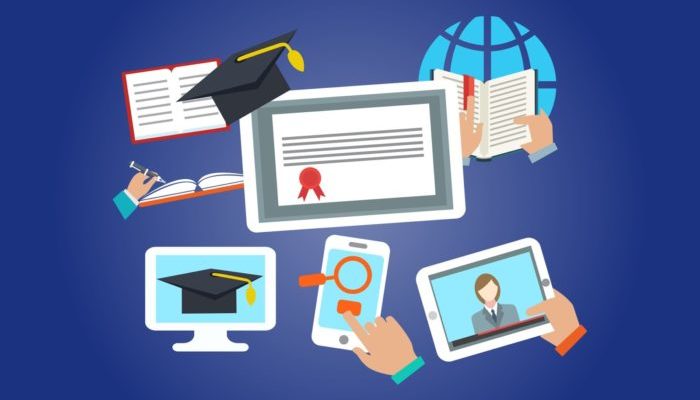
It has been a long year since the start of the COVID-19 pandemic. We all had to adjust and deal with a completely new reality, and it hasn’t always been easy. The adjustment has involved every aspect of life including the education system. When contact restrictions are in place and you cannot meet in person your students, your teachers, how do you continue to provide this crucial service? All universities and schools had to come up with solutions, some may have had some virtual learning platform already in place that could be implemented, some may have had to start from almost scratch. Ivan Oliveira shares with us which innovative steps the ITC Faculty of the University of Twente implemented to guarantee a proper educational service to all their students.
(Digital) Education at the ITC Faculty
The ITC faculty of the University of Twente has a long story of distance education which precludes the digital age, they used to mail teaching material on paper in the past and started early in the digital age shipping floppy disks, and later on CDs with their courses (before the internet was accessible enough). When I started working at the Faculty at the end of 2017, all the education was supported by digital tools and every course (face to face or distance education) made use of the Learning Management System (LMS) available to a certain extent.
When I say that, it might sound that the education at ITC could be cold and “distant” but nothing could be farther from the truth. The social atmosphere in the Faculty is incredibly warm. Both staff and students are mutually receptive and friendly which I feel is also helped by the lower importance of hierarchy in the Dutch culture.
During the years of 2018 and 2019, I spent my time implementing a new LMS (Canvas), helping teachers migrate content from the old LMS (Blackboard) and making sure that during the process, courseware would follow the same template, which created consistency between courses – the reasoning being that it would make students’ lives easier starting a new course which looked like the previous one. I also tried to drive the teachers to use the LMS to the extreme: prefer digital submissions instead of paper submissions, use Rubrics in the software and the grading system in the LMS instead of grading on paper or excel, offer exams digitally using digital proctoring, search for tools or LMS functions which would make their work easier and more effective.
My job could have been much more difficult had I not had the support of all my teaching colleagues. They are a group of very bright, open-minded, competent people who will always embrace change and applaud innovation. And more importantly, be patient with me whenever I fail. I am very proud to support them and be part of their team.
All this effort during these two years turned out to be quite a preparation for the tragedy which was to come.
The start of the Pandemic
When the Pandemic hit the Netherlands and the inevitable lockdown started, we were in the middle of a quartile (our academic year is divided into 4 periods of three months per year). Staff and students were sent home and education was halted for one week to give teachers and staff time to adapt and figure out how to proceed.
My workload as an eLearning Specialist, which was already high, tripled overnight. I would get call after call and still needed to find time to write guides, get acquainted with new software, help teachers with their courseware and videos.
While the official instructions within the University were for us to go back into teaching after two weeks, most of the education at our faculty was ready and running after just one week of preparations.
Teachers were quick to convert their teaching into a mix of online lessons, pre-recorded videos, online Q&A sessions, discussion boards, among others. All of the practical sessions and software tutorials were done online using conference tools and sometimes making use of remote access software for the guidance of the students.
Some of the small fieldwork experiments were filmed by the teachers with their mobiles to try to give students some of the experience they would have had access to otherwise. In other cases, students were provided with field data sets from previous field campaigns, to replace their own field measurements that could not have been taken since all fieldwork was cancelled.

Image Credit PIXABAY
Some examples of teacher adaptation
During the first weeks, while still in emergency mode, I was asked to adapt different types of face-to-face interaction to online interactions.
A very interesting example was done with Prof. Karin Pfeffer and Rosa Aguilar for a peer review of posters. This was scheduled to be an event where groups of students would print their posters and present them in a large room. Peers would come and make comments on these posters. Given the impossibility of the event, we created in Canvas a discussion item (forum thread) for each of the posters, where students could see the poster in high resolution and had the option to leave comments at the bottom of the page. To make navigation easier, we created a poster gallery with thumbnails for all the posters which would link to individual discussion threads. This made the peer assessment possible without the use of any other tool besides the LMS.
You can watch an interview with Prof. Karin Pfeffer and Rosa Aguilar here: https://vimeo.com/417929217
The second type of interaction that worked very well was created for the course of Dr Chris Hecker. His pre-pandemic plans were to have students present their works in an auditorium and have the audience (their peers) comment on their PowerPoint presentation and their presentation skills. Again, we had to adjust to the new reality. To achieve similar results, we made use of a Video Review tool offered by Techsmith. This tool allows for the revision of videos where peers can draw and annotate over the video itself. Each group of students recorded their presentation in the video, the presentations were uploaded to this platform and students would receive a link to the video they were supposed to comment on. The experience turned out quite well and the University of Twente is looking at the moment into including a similar tool into the University’s digital toolbox.
You can watch an interview with Dr Chris Hecker here: https://vimeo.com/415829605
A final example was the use of video. I could use many different examples but will limit myself to the use that Dr Anna Grigolon made of it. During the one week teachers had to adapt to the new situation, Dr Grigolon decided to shift her teaching method to use a flipped classroom. She pre-recorded all of her lessons using the simplest tool of all: Powerpoint and made them available beforehand to students. Students could watch and re-watch the lecture at their own time, and instead of joining the teacher for an expositive lesson, they would join for a discussion on the topic and a Q&A session. Videos were hosted on Vimeo where we collected detailed analytics of audience interaction. This specific experience gave me insight into the use of long videos: Dr Grigolon’s videos were almost all longer than 45 minutes, but analytics show that all students watched the videos to the end, which is something I wish to study further in the future.
Online proctoring
One of the biggest challenges from an eLearning Specialist perspective was remote proctoring. Since before I arrived at ITC, the faculty offered exams with remote proctoring using Respondus Lockdown Browser and Respondus Monitor for various different distant courses and Respondus Lockdown Browser for part of the locally written exams. After my arrival that continued to be true.
Once remote proctoring became mainstream, being used not only for all of our exams but for all of the Universities in the Netherlands, issues which we didn’t face before began to arise on a national scale. These issues included trust in the platform to catch fraud, the privacy of students, GDPR compliance, etc.
Having had enough experience with online proctoring in the past helped us to make the right decisions and to keep using proctoring, although with new guidelines, for instance, that all exams should be “open book”.
Administering an exam with online proctoring is also not a “flip of a switch” setting. A lot of things can go wrong with the different parts involved (LMS configuration, Proctoring Tool, Proctoring client, student’s computer, internet connection, human error from the teacher, etc). In order to mitigate possible problems, the eLearning Specialists go through a long “pre-flight checklist” for each exam, which costs a lot of time. Once the faculty started offering multiple online exams in a single day instead of two or three per month, this became an issue.
In this video you can watch an interview I conducted with Dr Caroline Gevaert on the use of the proctoring at ITC:
Back to the office
After the summer break, we slowly started to go back to the office. While most teachings were once again done inside the building (respecting distancing and other hygiene rules) not all students could be present, there would always be someone with a fever or coughing who would need to quarantine in their homes. This new situation brought us to a new situation: hybrid teaching.
Hybrid teaching can be presented in different ways, but for us, it was mostly teachers interacting face-to-face with students, while at the same time broadcasting their lessons and interacting with students online.
To support hybrid teaching technically, we developed two different solutions. Our high-end solution consists of professional-grade cameras, video switchers, lavalier microphones, and other equipment that needs an operator. This solution is used for larger classrooms where more quality is necessary.
Our low-end solution consists of one or two webcams on a pedestal and one or two conference microphones, all connected to the teacher’s computer. This turned out to be the preferred solution by teachers at ITC.
Looking to the future
The pandemic has been a wild ride until now with a lot of energy spent on making students’ lives a bit easier.
It was a period in which most of our energy and creativity was spent reacting to the circumstances rather than being proactive.
On the other hand, it was a wake-up call that forced us to accelerate the adoption of digital technologies that had been proposed but were being held back by bureaucracy, lack of focus, different objectives.
It also started a major movement inside our Faculty to share experiences and knowledge on the education-related to Geoinformation and Earth Observation, which is now an internal project aimed at compiling experiences from teachers, bringing external speakers to share their knowledge and become a central resource for us and our education partners.
Bark Krol and Luigi Lombardo contributed to the realization of the blog post.
Post edited by Shreya Arora, Gabriele Amato, Valeria Cigala

Obiokafor
Currently I am on a research work for distance learning. Please I want to contact you so as to access more practical information from you concerning e-learning . Thanks
Vale Cigala
Hi!
You can look up Ivan Oliveira’s contact information at the University of Twente.